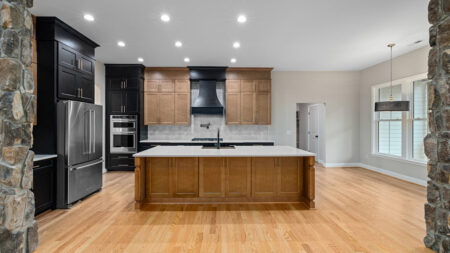With soaring electricity prices – with a low probability of them ever coming down – energy-efficient home upgrades are at the top of homeowners’ to-do lists. Many homeowners pull out all the stops to lower their utility bills while maintaining a comfortable temperature throughout the house. Windows are the main reason for heat loss during cold months and heat gain in summers. Therefore, their inspection, repair, or replacement becomes the starting point.
The basement windows often remain out of mind and that’s why many homeowners fail to improve the situation significantly. Old or poorly insulated units keep adding load to your HVAC system, leading to higher energy use and inflated utility bills. Hence, repairing or replacing a faulty basement window can be the key to your home’s energy efficiency.
In this article, you will find a comprehensive guide to basement window replacement with a step-by-step approach in mind. It breaks down the process, making it simple and hassle-free, regardless of your handyman skill level.
Table of contents
- Warning signs
- Things to know before replacement
- Basement window types
- Egress requirements
- How to replace basement windows
- How windows boost energy efficiency
Warning Signs: When Should You Replace Basement Windows?
A modern busy lifestyle with tight deadlines doesn’t leave much room for regular house inspection. This is why many homeowners are not able to figure out when their windows start malfunctioning and require repair. The basement window units usually get even less attention unless you’ve created a workspace, recreation area, or gym downstairs. How do you know it’s time to invest in a brand-new basement window installation? Here are a few warning signs to notice to consider basement window replacement.
Water Leaks or Condensation
A poor window installation can result in water leakage and condensation buildup inside the unit. Although you may believe that a few drops don’t require swift action, the moisture can lead to property damage like wall discoloration, peeling paint, or structural issues.
Higher Than Normal Utility Bills
Once windows lose their insulation strength, they start letting out warm air in winter and cool in summer, making your HVAC system struggle. Even though a spike in your electricity bills won’t happen overnight, you can waste hundreds of dollars in the long run. So, the basement window replacement for a malfunctioning unit is a smart financial move as well.
Cracks or Breaks
A visual check can be enough to detect deformities in your window units, pointing to a need for replacement. Apart from reducing your window’s aesthetic appeal, cracks or breaks pose security risks as they provide easy entry points for pests and other unwanted guests.
Mildew and Mold
The appearance of black mold around units or on window sills means persistent water intrusion and excess humidity combined with inadequate ventilation. In addition to the visual sign, you can notice a musty odor, typically in damp environments. If ignored, it can cause allergies, respiratory issues, and structural damage to the surrounding walls. Thus, it is better to know how to install basement windows without any further delay.
Noticeable Drafts and Outside Noises
If you feel air coming from the window or hear outside noises more clearly, this indicates seal failure. In addition to increased energy bills, your home may become less comfortable during windy conditions or in noisy neighborhoods.
Poor Window Operation
You need to remove basement windows and install new ones if they have become ‘jammed’ or you find it hard to open and close them. It is especially essential for units that are supposed to be your emergency exit.
Visible Decay or Rot
As decay results from persistent water damage, chances are that your window is one step away from collapsing. On top of that, rot serves as a welcome call for pests like ants and termites, further compromising your home’s structural integrity.
Also Read: Best Motorized Smart Blinds, Shades and Retrofit Kits
Things to Know Before Basement Window Replacement
Whether as part of a basement renovation or a stand-alone project, window replacement requires preparation to get the best result. That’s where you need to examine all available options, decide if you want to hire a specialist, and employ a window replacement cost calculator to make a realistic budget. Moreover, it’s worth paying heed to the following points.
Understand Your Goals
Gone are the days when homeowners had to agree on the only available model of basement windows. The modern market is brimming with options designed to fit any need and budget. Thus, before embarking on the project, decide what you want to achieve with it. You may want to increase natural light and improve ventilation or you might plan to block outside noises and upgrade the aesthetic appeal. Your primary goals can dictate the selection of basement replacement windows.
Consider Window Type and Frame Material
Once you decide about installing basement windows, select the ideal unit configuration – hopper, awning, sliding, or casement. These options can come with a vinyl, aluminum, wood, or fiberglass frame. The weather conditions and maintenance requirements should be the main decision-driven factors.
Measure the Space Properly
Accurate measurements make for a cornerstone of the project’s success. To ensure that your brand-new unit will fit the window opening, measure its width, height, and depth precisely. In other words, you should determine the exact width and height in three places: at the bottom, middle, and top.
Estimate the Project Cost
Adequate planning and budgeting are key to installing a basement window. Your expenses can vary depending on the unit’s dimensions, frame material, and installation charges. Hence, getting quotes from different providers to compare the options is a smart and proactive approach.
Employ Online Tools for Personalized Quotes
If locating reliable contractors and requesting bespoke estimates feels like a backbreaking task, you can employ effective online tools like MyHomeQuote to make it easy for you. There, you need to fill in a single questionnaire with your project details to get about five personalized quotes.
Types of Basement Windows
While basements are often seen as dim and uninviting, they hold immense potential as adaptable and useful areas. The additional space downstairs can be utilized for storage, utilities, home offices, personal gyms, or even extra bedrooms.
Current housing trends indicate a shift from traditional living spaces to more versatile, multifunctional areas. Basements perfectly align with this modern preference. Thankfully, there are numerous window solutions available to illuminate your basement, turning it into a welcoming and functional area that appeals to many, rather than the typical dingy spaces.
Egress

Egress windows are positioned beneath ground level and are accompanied by a window well outside, equipped with steps or a ladder for emergency exit or entry. These windows are primarily designed with safety in mind, often being larger than standard basement windows.
Daylight

Daylight windows offer a great solution for illuminating your basement without requiring egress capabilities. While they are generally smaller than egress windows since they aren’t designed for exit or entry, they still bring in a substantial amount of natural light and help keep the space bright and airy.
Walkout

As implied by their name, walkout windows provide a convenient passage or entryway between the basement and the outside. They are usually fitted in basements situated on uneven ground or elevated foundations, ensuring that the windows are entirely above the ground level.
Glass Block Windows
Glass block windows were commonly installed in older homes because basement living was not widely favored, and there was no obligation for egress windows at that time. These windows are constructed by mortaring individual glass blocks or bricks together to create a window.
You can also check out our detailed guide on different window types. This feature article may help you understand various window types and their benefits for your household. Something to consider for your next renovation project.
Understanding Egress Requirements for Basement Windows
While many homeowners turn their basements into a mix of laundry and warehouse, others create a playroom, guest room, or fitness studio in it. However, once you decide to use your basement as a living space, you need to consider how to install basement replacement windows that can serve as an emergency escape route. As such units come with specific requirements, you need to meet them all to comply with building regulations.

Size Requirements
The window opening must be large enough for you and your family members to fit through – 5.7 square feet at least. According to the IRC, such a unit must be a minimum of 20W x 24H inches.
Window Accessibility
Please note that an egress unit must be operational from the inside without keys or tools. The opening must not be higher than 44 inches from the floor.
Building Codes and Regulations
As building regulations vary across the country, basement egress units have been governed by the IRC since 2018. It states that every home space used for living must have natural light and proper ventilation.
Professional Installation
Given the complexity and the legal implications of egress unit installation, hiring professionals is the best choice. They have enough experience to install windows in the basement, no matter how sophisticated the project is. You shouldn’t attempt DIY-ing such a significant project if you are an amateur.
Masonry Work
For installing an egress window into the basement, homeowners often need to cut an opening into the basement’s concrete foundation wall. An expert has a specialized concrete saw or chainsaw to get things done. Moreover, they are unlikely to cut through a crucial load-bearing structure.
Navigating Beam Challenges
Heating ducts or support beams may be located in a place ideal for a basement window to be installed. In this case, specialists will have to redirect ductwork or re-support affected beams.
Window Well Excavation
The creation of window wells requires specialized equipment and knowledge, as this involves digging outside the basement. Your egress unit must open fully for a person to climb out. Professionals can take care of all the intricacies, from creating a ladder for easy egress to drainage.
How to Replace a Basement Window? Step-by-Step DIY Guide
If hiring a professional is not your way of action or you can’t afford to cover labor costs, you can undertake the project yourself. To achieve the desired results and eliminate critical mistakes down the road, you need to gain some knowledge and purchase the equipment required to fix the units. Let’s delve into how to replace basement windows on your own.
Tools Required for Replacement
Even though the process of replacing a basement unit may seem a standard one, it can involve some pitfalls, meaning that you may need some specific equipment on the spot. The list of must-have tools involves but is not limited to:
- Measuring tape
- Screwdriver
- Utility knife
- Pry bar
- Hammer
- Drill/driver
- Caulking gun
- Waterproof shims
- Safety equipment
Instructions
Want your DIY basement window replacement project to become a point of pride? Then, it is vital to examine and understand the manufacturer’s instructions for your specific window model. Each configuration comes with unique installation requirements that you need to follow.
Measuring a Window Opening
You need to measure the width at the top, middle, and bottom of the window opening. For the height, measure the right, left, and center. In all cases, use the smallest measurement.
Getting a New Window Unit
Once you have the exact measurements for your window, check them again for certainty. If you need a unit of a standard size, chances are you can purchase it right away, as custom orders always have a longer turnaround time.
Dismantling the Old Window
How to remove a basement window? Start with taking off the trim and molding from around the structure, followed by the window stops and sashes. Here, you need to take special care to prevent injuries from the glass or sharp edges.
Inspecting the Window Opening
When the old unit is out, you can see the whole picture. Inspect the window opening for water damage, rot, or other issues that can affect installing a basement window afresh and fix them.
Mounting the New Window
It’s better to seek some assistance if the unit is medium-sized or large. You’ll need to slide it into place, ensuring it is centered in the opening.
Securing the Window
Once the window is in the correct position, use screws and shims to secure it to the opening. Make sure the window opens, closes, and locks properly after it is secured.
Weatherproofing and Insulation
One of the main purposes of replacing a basement window is to improve energy efficiency. Thus, you need to use high-quality insulation materials to fill gaps between the window and frame.
Sealing and Caulking
You need to apply caulk around the window’s exterior to seal all the gaps and keep water leakage at bay. Additionally, you need to replace the window trim and seal the unit from the inside to provide a finished appearance.
How Properly Functioning Basement Window Boosts Energy Efficiency
A well-sealed and insulated basement unit significantly contributes to your home’s energy efficiency. It prevents warm or cool air from escaping, reducing your heating and cooling expenses and, thus, your carbon footprint. Moreover, it can eliminate the intrusion of cold drafts, lowering the burden on your HVAC system. Therefore, if you can’t afford a replacement, getting professional basement window repair services can be a smart alternative. Such a step may help you stay comfortable at home all year round without extra effort.
FAQs About Basement Window Replacement
A: You can start by removing the old window and its frame. Use a hammer and chisel to enlarge the opening, if necessary. Once you insert the brand-new unit frame, utilize shims to level, and secure it with masonry screws. Follow the manufacturer’s instructions on how to install the window sash.
A: Measuring and cutting out the opening in the basement wall are the primary steps. You can install a window well if necessary. Position the window in the opening, ensuring it is level and square. You can employ anchors to attach the unit to the concrete, then seal it with caulk.
A: First off, you need to take off screws or nails holding the window sashes and frame. You can use a pry bar and hammer to lift out the sashes. If the unit is sealed with caulk, you need to cut it away and remove the window jamb.
A: To start the ball rolling, take precise measurements of the window opening first. The second step is to remove the old unit and inspect the opening for any issues. When installing a new window, use shims to ensure the proper position. Secure the window with screws, then seal it with foam insulation and waterproofing membrane.
Follow Homecrux on Google News!




